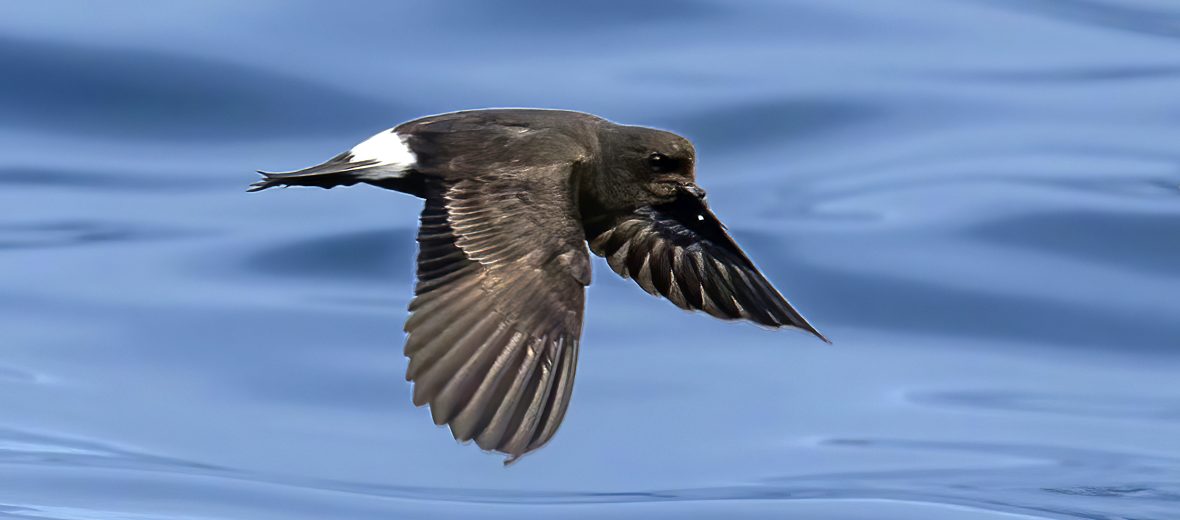
The European storm petrel, aka storm petrel or British storm petrel, has a wide distribution and can be found off the coasts of Europe and western Africa. They are migratory birds that spend their winters off the coast of western Africa and their summers in the northern Atlantic, off the coast of Europe. These birds are oceanic but breed and nest on land on uninhabited islands. Due to their large populations, these birds are listed as Least Concern by the IUCN. They number an estimated 519,999 wild individuals. The only threat they face is that of invasive species that can bring about predation and disease.
First the Stats…
Scientific name: Hydrobates pelagicus
Weight: Up to 1.34 ounces
Length: Up to 7.1 inches
Wingspan: Up to 15 inches
Lifespan: Up to 33 years
Now on to the Facts!
1.) These gregarious birds can be found in large flocks throughout the year.
2.) Throughout most of the year, they are diurnal (active during the day). However, they switch to a nocturnal (active at night) behavior during breeding season.
3.) While the Mediterranean subspecies can dive to depths of up to 16 feet, most storm petrels only dive to depths of up to 20 inches. Most of their food collection is acquired by skimming the water’s surface for top feeding fish.
4.) They can travel upwards of 120 miles per day in search of food.
5.) Just like all petrel species, they are awkward and clumsy on land.
But wait, there’s more on the European storm petrel!
6.) Their flight resembles that of a bat.
7.) The vocalizations include an in-flight “wick-wick-wick” and a “up-CHERRK” alarm call. The males will also emit a sort of purring sound to their mate during the breeding season. The chicks emit a “pee-pee-pee” call during feeding.
Did you know…?
Storm petrels are often utilized as a symbol by anarchist as well as revolutionary groups.
8.) A group of petrels is called a flock or gallon.
9.) Small fish, crustaceans, squid, and jellyfish are all on the menu. Offal (gutted fish) and zooplankton are also often consumed, as well as whale carcasses (whenever they happen to show themselves).
10.) In breeding colonies, on land, these birds will often consume insects and even some plant matter.
But wait, there’s still more on the European storm petrel!
11.) The European storm petrel is monogamous (mates for life).
12.) Breeding takes place between May – June.
Did you know…?
After the first week, mom and dad will not stay with their chick and only stop in to feed their offspring throughout the day.
13.) They utilize the same nesting hole each year.
14.) Their nesting tunnel can be up to 118 inches deep.
15.) While not typically overly territorial during nesting, they will defend their chick from predators the best they can.
But wait, there’s still a little more on the European storm petrel!
16.) The female will lay a single egg that hatches in up to 50 days.
17.) Both parents take turns incubating the egg, while the other one looks for food.
Did you know…?
Sailors used to believe that storm petrels foretold dangerous tempests (storms).
18.) Like so many other birds, the chicks are hatched altricial (helpless).
19.) Storm petrel chicks are fed a steady supply of crop milk (regurgitated oily stomach contents) throughout the day.
20.) After roughly 50 days, the parents will start leaving the chick for sometimes days at a time in between feeding.
But wait, there’s still a tad more on the European storm petrel!
21.) As soon as the chick can leave the nest hole the parents, often times, stop visiting it altogether.
22.) Chicks fledge in up to 86 days.
23.) Falcons, gulls, owls, and skuas are their primary predators. However, some mammals, like rats, will attempt to take the chick or the egg; whichever happens to be in the nest.
Now a Short European Storm Petrel Video!
Be sure to share & comment below! Also, check out the Critter Science YouTube channel. Videos added regularly!
Want to suggest a critter for me to write about? Let me know here.
Some source material acquired from: Wikipedia & IUCN
Photo credit: Charles J. Sharp



